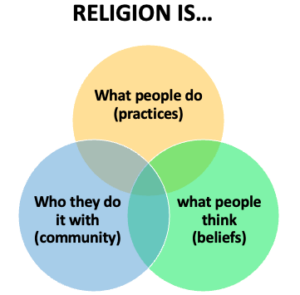This lesson offers some historical information about the first Bat Mitzvah, the welcoming of a young Jewish woman to adulthood. Jews had for centuries celebrated a boy’s entry to adulthood with a Bar Mitzvah, meaning, ‘son of the commandments’. In 1922 Rabbi Mordechai Kaplan, a member of the Orthodox Jewish community in New York, performed the first Bat Mitzvah, for his daughter, Judith. This means ‘daughter of the commandments’. As we shall see, not everyone welcomed the move. We will explore historical information as well as information about Jewish belief, practice and community.
Lesson Outline
1. Search online for an image of Judith Kaplan at the 70th anniversary of the first Bat Mitzvah. The image is housed in the Jewish Women’s Archive, there are several versions online. You could also search for other images of Judith and her father Mordechai Kaplan, there are a few.
Give groups 3 minutes to come up with 3 questions about the image.
2) Cut the information below into cards and give a set to each group: (In the download at the end of this page there are ready made cards you can cut out.)
Judith’s father was a rabbi, and he performed her Bat Mitzvah
Bar Mitzvah is when a boy comes of age in Judaism
Judith Kaplan’s Bat Mitzvah was conducted in New York in 1922
No one had conducted a Bat Mitzvah before Judith Kaplan’s.
The young person reads from the Torah in front of the congregation
The first public Bat Mitzvah involved 13-year old Judith Kaplan
There are 316 commandments in then Torah (Jewish holy book)
Bat means ‘daughter’ in Hebrew
Bar Mitzvah means ‘son of the commandments’.
Ask groups to find answers to these questions, using the cards:
– What is a Bat Mitzvah?
– What is a Bar Mitzvah?
– why is the first Bat Mitzvah is significant in Jewish history?
3. Ask groups to predict how this was received in the Orthodox community. Do they think it was welcomed as a positive change, or resisted as an unwelcome change?
4. In fact not all New York Jews supported Judith’s Bat Mitzvah. Write the 4 statements below into 4 speech bubbles and display. Ask groups to identify TWO reasons why Judith’s Bat Mitzvah was seen as a bad idea, and TWO reasons why it was seen as a good idea.
A woman’s sphere of influence is the home, so it is right and fitting that a young woman should be welcomed into adulthood in the home.
Religions need to change with the times. Traditions adapt without destroying the religion. The belief has not changed, just the way of showing it has changed.
Women have more of a role in public life in modern times so it is correct for women to be more involved in public religious ceremonies.
Jewish women and girls have always been ‘daughters of the commandments’. A new ceremony is not necessary.
5. Introduce the idea that religion can be understood as a combination of beliefs, practices and community or tradition; how groups see the world, what they do, and who they do it with. Show a diagram like this. You could give examples of beliefs, practices and community traditions, which pupils have to match to each element to make this point.

6) Using the information squares below, answer the question; ‘Was Rabbi Kaplan seen as challenging religious beliefs, practices or traditions with the first Bat Mitzvah?’
The Torah is the first part of the Jewish bible, consisting of 5 books.
The 613 commandments cover all aspects of community & religion.
The Torah teaches about the Jewish prophets and early Jewish history.
Traditionally only men read from the Torah.
‘Torah’ means ‘teachings’ (Hebrew).
The Torah begins with God creating the universe.
The Bar Mitzvah ceremony is not mentioned in the Torah, or the Talmud (books that interpret the Torah).
The first mention of the Bar Mitzvah ceremony is in the Middle Ages, not the time of the Torah.
Traditionally, only men would read from the Torah in public. Women had no roles of authority in public; in business or religion.
The Jewish bible contains elements of the Bar Mitzvah ceremony. For example, adult Jews fast on the Day of Atonement, and children would begin their fast at 13.
At a Bar Mitzvah ceremony, the 13-year old boy reads a portion of the Torah to the congregation at the synagogue. This is the first time he has read from the Torah in public.
The Mishnah (part of the Talmud) states, ‘”At five years old one should study the Scriptures, at ten years for the Mishnah, at 13 for the commandments…’ (Mishnah Pirkei Avot 5:21)
